Remote Work Statistics 2023
Delve into the most recent Remote Work Statistics for 2023 and gain valuable insights and data on the influence of remote work in the modern world of employment and organizational dynamics.

Remote Work Statistics 2023
Delve into the most recent Remote Work Statistics for 2023 and gain valuable insights and data on the influence of remote work in the modern world of employment and organizational dynamics.

In recent years, remote work has taken center stage, transforming how we approach our careers. The importance of remote work cannot be overstated, as it blends the convenience of technology with the flexibility of modern life. So, whether you're a seasoned professional or just starting your journey, remote work opens doors to new possibilities, offering a chance to strike a harmonious balance between work and personal life while fostering productivity and creativity.
Here, we have compiled a comprehensive list of the most recent remote work statistics to provide you with a deeper insight into this evolving phenomenon, where the office extends far beyond four walls, and the possibilities are as vast as the digital horizon.
Key Findings
- On a global scale, full-time employees worked remotely approximately 0.9 days a week in 2023.
- 91% of professionals express a positive experience with remote work.
- 79% of managers see increased productivity when their teams work remotely.
- As of August 2023, 13% of full-time employees have transitioned to a fully remote work model.
- In the Information, Finance & Insurance, and Professional & Business Services industries, 21% of the workforce now works remotely full-time.
- 31% of remote workers would consider job hunting if faced with a full-time office return mandate, while 6% are willing to resign.
- 29% of employees returning to the office expect a pay increase.
Topics Covered

Global Remote Work Statistics

Perception of Remote Work

U.S. Remote Work Statistics

Remote Work Vs. Organizations

Remote Work Vs. Managers

Remote Work Vs. Employees
Topics Covered

Global Remote Work Statistics

Perception of Remote Work

U.S. Remote Work Statistics

Remote Work Vs. Organizations

Remote Work Vs. Managers

Remote Work Vs. Employees
Global Remote Work Statistics
On average, full-time employees worked remotely approximately 0.9 days a week in 2023. English-speaking countries like Australia, Canada, New Zealand, the U.K., and the U.S. reported higher levels of remote work, with employees working an average of 1.4 full-paid days per week from home.
In contrast, remote work was less prevalent in Asian countries (0.7 days per week on average), European countries (0.8 days per week), and four Latin American countries (Argentina, Brazil, Chile, and Mexico) plus South Africa (0.9 days per week).
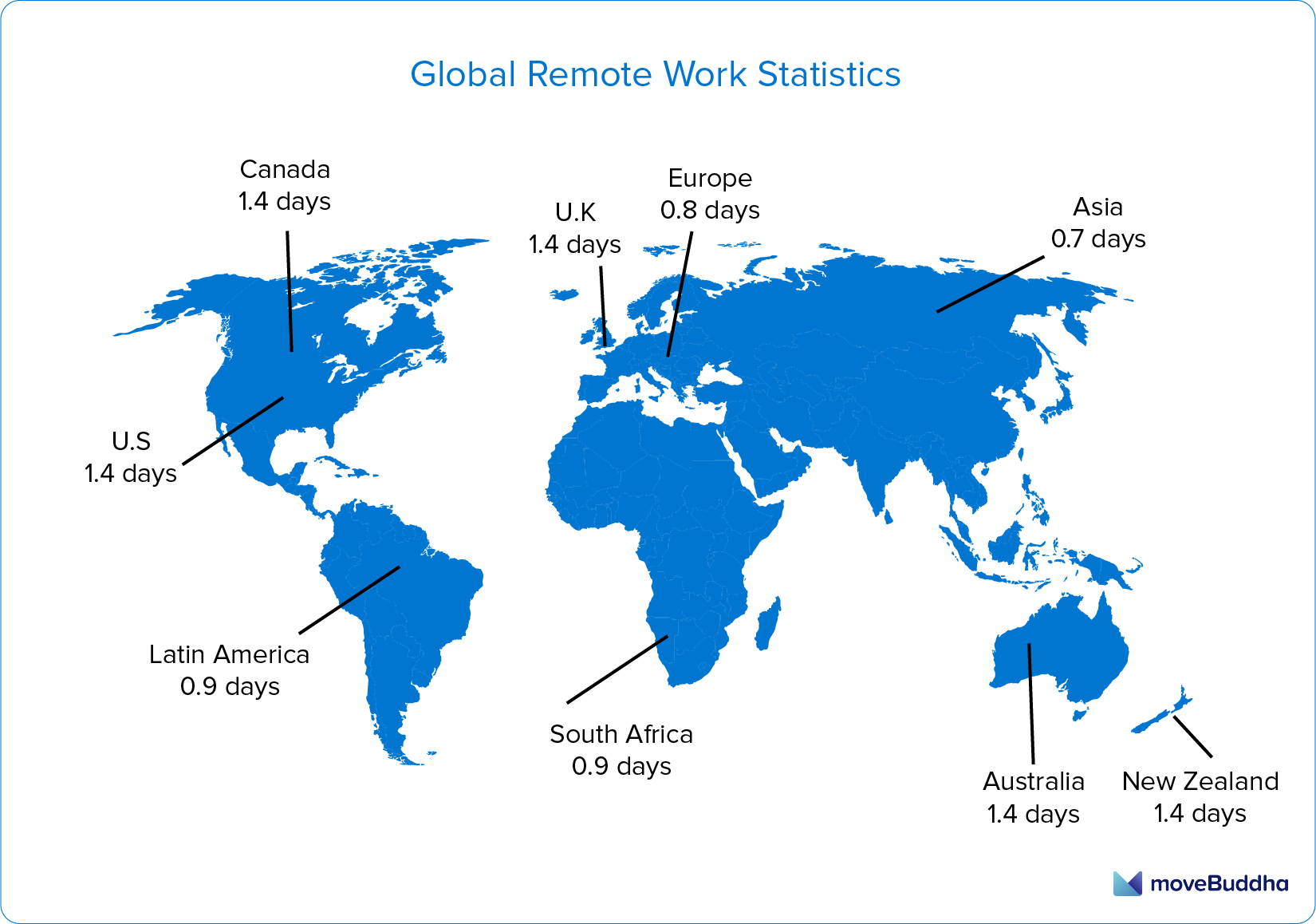
There's a noticeable difference between what employees wish for regarding remote work days and what employers have in mind. On average, employees across the globe desire around 2.0 days of remote work per week, while employers are planning for just 1.1 days.
This gap isn't limited to one place; it's consistent across 34 countries. It's most pronounced in Latin America and South Africa, where employees want to work 1.3 days more from home than their employers intend.
In contrast, English-speaking countries have a smaller gap, averaging 0.7 days. Some of the widest gaps are found in Argentina (1.6 days), Brazil (1.2 days), and Mexico (1.2 days), whereas the narrowest gaps are observed in Japan (0.2 days), the Netherlands (0.3 days) and Denmark (0.4 days).
Perception of Remote Work
The work landscape continues to evolve, and recent data underscores the ongoing appeal of remote work. With an overwhelming majority of workers expressing a strong preference for remote work and high satisfaction rates, it's evident that this flexible work model has become a lasting and highly recommended choice for many professionals.
The data suggest that:
91%
of professionals express a positive experience with remote work.
98%
of professionals prefer incorporating remote work into their long-term careers, a slight increase from 2022's 97%.

98%
would now recommend remote work to others, up from 97% in the previous year.
79%
of managers see increased productivity when their teams work remotely.
Remote work eases stress
Besides having the chance to relocate cities more freely, remote work offers employees greater control over their work-life balance, minimizing stress from commutes and rigid office schedules.
The latest statistics on remote work highlight its significance in positively impacting mental health.
While 59% of full-time office workers have reported increased stress levels in recent years, the figures are comparatively lower for hybrid workers at 55% and remote workers at 36%.
Other benefits of remote work
Remote work offers numerous advantages, but one standout perk people love is its incredible flexibility. 22% of respondents agree that the most significant benefit of remote work is the freedom it offers in managing their time.
Additionally, 19% highlight the joy of choosing where to live, and 13% relish the ability to pick their work environment as a major plus.
Challenges of remote work
Although remote workers enjoy many advantages, this type of working also poses many obstacles.
The most significant challenges remote workers face include staying home too often due to a lack of reasons to leave (21%), experiencing loneliness (15%), and dealing with the complexities of working across different time zones (14%).
Despite 71% of respondents emphasizing the importance of establishing work boundaries, remote workers have yet to succeed in this matter.
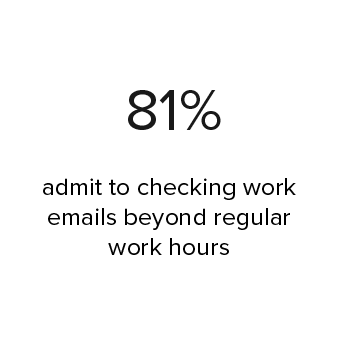
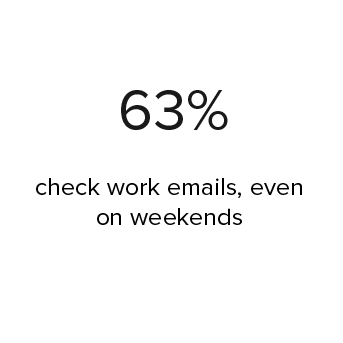
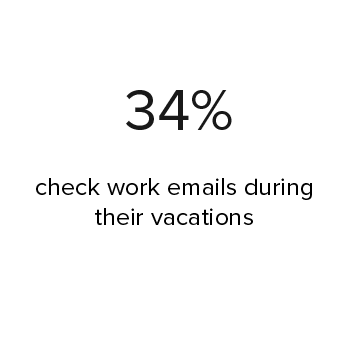



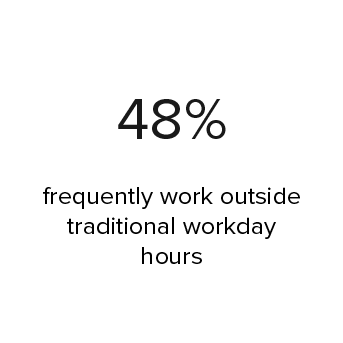
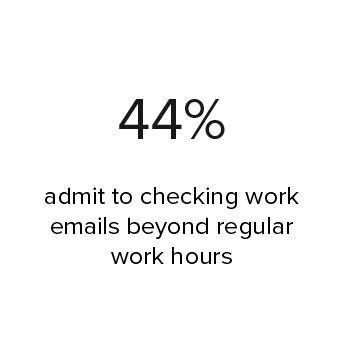
U.S. Remote Work Statistics
As of August 2023, there have been notable shifts in the workforce. Specifically, 13% of full-time employees have transitioned to a fully remote work model, embracing flexibility.
A majority, 57%, have chosen to remain in the traditional full-time on-site work setting. Additionally, 30% have opted for a hybrid work arrangement, balancing remote and on-site work.
Common remote work options
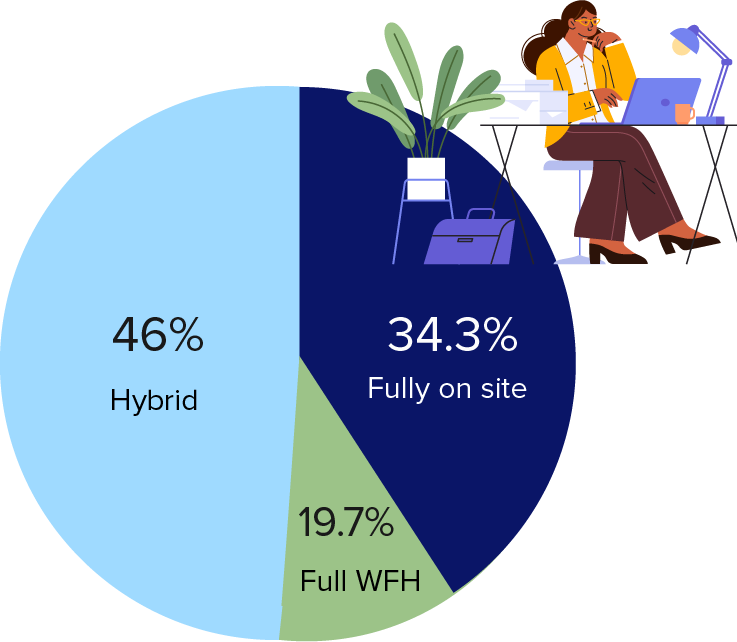
The most dominant approach among employees who can work remotely is the hybrid model, which combines both on-site and remote work. According to recent statistics, approximately 46% of employees follow this work arrangement, allowing them to balance the office environment and the comfort of their homes.
Additionally, around 34.3% of people still adhere to the traditional entirely on-site work model, where they exclusively work from their designated workplace. On the other hand, a smaller but notable 19.7% have embraced full work-from-home (WFH) arrangements, which enables them to carry out all their responsibilities remotely.
Remote work by age
Remote work is a preferred option regardless of the age category. More specifically, the data reveals that in the youngest age bracket (20 – 29 years), approximately 11.2% of individuals opt for a complete work-from-home arrangement. As we move to the next age group (30 – 39 years), the proportion of those choosing full WFH increases to 13.2%, indicating a slightly higher inclination towards remote work than the younger generation.
Within the 40 – 49 age bracket, 12.7% of individuals are inclined towards the full work-from-home model. Furthermore, it is intriguing to note that even among those aged 50 – 64, a consistent 13.2% choose full WFH.
Remote work by industry
It is a good day to be part of the Information, Finance & Insurance, and Professional & Business Services sectors since they are at the forefront of the shift toward hybrid and remote work arrangements. In these industries, 21% of the workforce has transitioned to full-time remote work, reflecting a remarkable adaptation to the evolving work landscape.
Other industries follow, as seen below:
Remote Work Vs. Organizations
The leading motivator for implementing remote work arrangements continues to be employee interest and requests, with 73% of employers citing this as a primary driver. Employers are also recognizing the importance of remote work in enhancing their branding and attracting top talent, as indicated by 53% of respondents.
Additionally, the ongoing talent shortage, acknowledged by 38% of respondents, highlights the need for flexible work arrangements to access the right skills.
While factors such as better internal skill utilization, COVID-19 restrictions, cost savings, and sustainability efforts contribute to the shift towards remote work, it's clear that meeting employee preferences and securing top talent remains at the forefront of this trend.
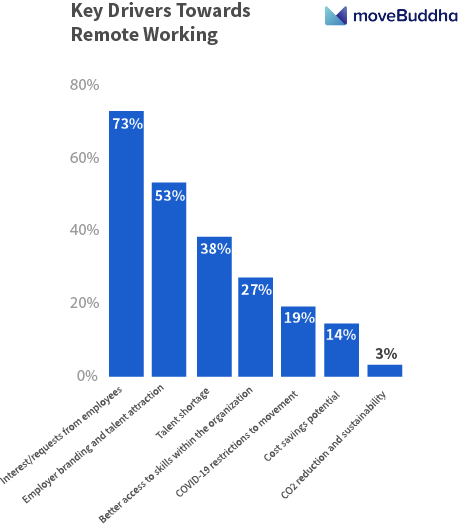
The challenges businesses face today regarding implementing remote work are diverse. Tax and legal compliance take the top spot at 82%, underlining the need to navigate complex regulations effectively. Managing permanent establishment risk is a concern for 65% of companies, emphasizing the importance of global operations management.
Establishing effective governance and processes for remote work, along with problems related to employee tracking and technology, add complexity to the remote work environment, with 43% and 30%, respectively.
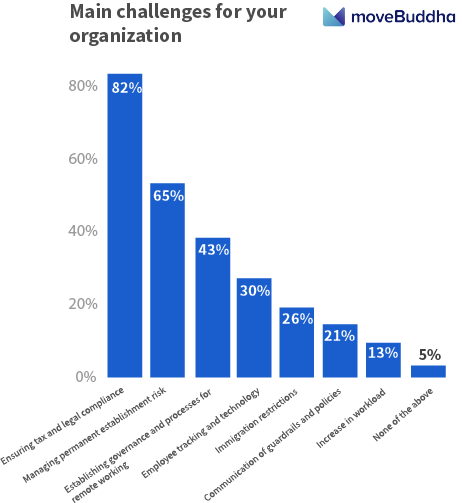
Remote Work Vs. Managers

The importance of a supportive manager becomes increasingly evident as one's work location moves further away from the traditional office setting.

However, this need intensifies for hybrid workers, with 87% highlighting the pivotal role of a supportive manager when balancing in-office and remote work.

Remote workers, who are entirely removed from the physical office environment, place the highest premium on supportive management, with a striking 92% considering it essential.
A supportive manager can provide remote and hybrid workers with the guidance, communication, and emotional support necessary for success in their roles, regardless of their physical distance from the office. But for managers overseeing remote or hybrid teams, there are many challenges on the way.
Some of the biggest challenges managers face are:

34%
IT support
Two of the most prominent concerns, each accounting for 34% of their worries, are IT support issues and the need to maintain cultural connection and effective communication within the team.

32%
Employee engagement
Employee engagement and satisfaction, at 32%, is another central focus area, as remote or hybrid work arrangements can sometimes lead to feelings of isolation or detachment among employees.

31%
Effecitve Management
Next, the ability to effectively manage remote or hybrid teams, cited as a problem by 31% of managers, underscores the importance of leadership skills tailored to this unique work setting, which often requires a blend of trust-building, accountability, and adaptability to navigate successfully.
Remote Work Vs. Employees
To some employees, remote work means a lot. A substantial percentage of those employees are willing to go to great lengths to preserve their remote work privileges, including the surprising willingness of some to resign rather than return to a traditional office setting.
Data shows that:
31 %
The desire for flexibility in the workplace has never been more evident, with a striking 31% of remote workers expressing their intent to job hunt if their employers mandated a return to the office full-time and a surprising 6% willing to resign rather than give up remote work.
29%
Furthermore, for those considering a return to the office full-time, a substantial 29% of them expect a pay increase as part of the transition. This indicates a significant shift in the expectations and preferences of employees, highlighting the growing importance of flexibility in today's professional landscape.

10%
Among those who would consider quitting if their employers required full-time office work, it's interesting that women represent the majority at 10%. At the same time, men are comparatively less likely to consider quitting, with only 1% showing a willingness to do so.
40%
Further data underscores the pivotal role of remote work flexibility in shaping modern employment preferences. With 40% of job seekers indicating that they would refuse a job offer if required to work in the office on specific days or if flexible working hours were not permitted, it's clear that a rigid, in-office approach is a potential deal-breaker for many.
Bottom Line
To summarize, remote work has emerged as a transformative and highly regarded work model, offering professionals the flexibility to balance work and personal life. While it comes with significant benefits, including increased job satisfaction and productivity, it also presents challenges, such as the need for clear work-life boundaries.
This shift towards remote work is driven by employee preferences and the quest to attract top talent, with its importance underscored by ongoing changes in work dynamics and industries. Ultimately, remote work is reshaping how we perceive and engage in work, emphasizing flexibility and employee well-being.

